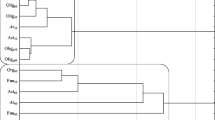Abstract
The influences of temperature, soil moisture potential and initial pH on the biotransformation of pentachlorophenol (PCP) by the lignicolous fungi Lentinula edodes and Phanerochaete chrysosporium were examined. At 10°C, L. edodes was more effective in degrading PCP (P < 0.05) than P. chrysosporium. At 15°C similar results were obtained for the two fungi. The highest levels of degradation occurred for both fungi at 25°C. With P. chrysosporium, the extent of PCP elimination was directly related to soil moisture content and optimal at approximately 47%. With L. edodes, in contrast, the process was inversely related to moisture content and maximal at 26%. The initial soil pH also had a marked influence, and pH 4.0 was optimal for both fungi.
Similar content being viewed by others
References
Brigua M, Middeldorp PJM, Salkinoja-Salonen MS (1992) Environmental factors influencing the biodegradation of pentachlorophenol in contaminated soils by inoculated Rhodococcus chlorophenolicus PCP-1. In: International symposium for soil decontamination using biological processes. DECHEMA, Frankfurt, pp 109–115
Bumpus JA, Tien M, Wright D, Aust SD (1985) Oxidation of persistent environmental pollutants by a white rot fungus. Science 228: 1434–1436
Cork DJ, Krueger PJ (1991) Transformations of herbicides and pesticides. In: Neidleman SL, Laskin AI (eds) Advances in Applied Microbiol, vol 36. Academic Press, San Diego, pp 1–66
Egan H, Kirk SR, Sawyer R (1981) Pearson’s chemical analysis of foods. Churchill Livingstone, Edinburgh, pp 15–19
Fewson CA (1988) Biodegradation of xenobiotic and other persistent compounds: the causes of recalcitrance. Trends Biotechnol 6: 148–153
Greer LE, Shelton DR (1992) Effect of inoculant strain and organic matter content on kinetics of 2,4-dichlorophenoxyacetic acid degradation in soil. Appl Environ Microbiol 58: 1459–1465
Greer CW, Hawari J, Samson R (1990) Influence of environmental factors on 2,4-dichlorophenoxyacetic acid degradation by Pseudomonas cepacia isolated from peat. Arch Microbiol 154: 317–322
Illman DL (1993) Hazardous waste treatment using fungus enters market. Chem Eng News, July 12: 26–29
Kohring G-W, Rogers, JE, Wiegel J (1989) Anaerobic biodegradation of 2,4-dichlorophenol in freshwater lake sediments at different temperatures. Appl Environ Microbiol 55: 348–353
Lamar RT, Dietrich DM (1990) In situ depletion of pentachlorophenol from contaminated soil by Phanerochaete spp. Appl Environ Microbiol 56: 3039–3100
Maliszewska-Kordybach B (1993) The effect of temperature on the rate of disappearance of polycyclic aromatic hydrocarbons (PAHs) from soil. Environ Pollut 79: 15–20
Mileski GD, Bumpus JA, Jurek MA, Aust SD (1988) Biodegradation of pentachlorophenol by the Phanerochaete chrysosporium. Appl Environ Microbiol 54: 2885–2889
Okeke BC, Smith JE, Paterson A, Watson-Craik IA (1993) Aerobic metabolism of pentachlorophenol by spent sawdust culture of “shiitake” mushroom (Lentinus edodes) in soil. Biotechnol Lett 15: 1077–1080
Okeke BC, Paterson A, Smith JE, Watson-Craik IA (1994) The relationship between phenol oxida soluble protein and ergosterol with growth of Lentinus species in oak sawdust logs. Appl Microbiol Biotechnol 41: 28–31
Parker LW, Doxtader KG (1983) Kinetics of the microbial degradation of 2,4-D in soil: effects of temperature and moisture. J Environ Qual 12: 553–558
Shang-Zhi S, Stanley G (1983) High-performance liquid chromatography analysis of chlorophenols in cardboard food containers and retailed materials. J Chromatogr 267: 183–189
Shelton DR, Parkin TB (1992) Effect of moisture on sorption and biodegradation of carbofuran in soil. J Agric Food Chem 39: 2063–2068
Wardle DA (1992) A comparative assessment of factors which influence microbial biomass carbon and nitrogen levels in soil. Biol Rev 67: 321–358
Wiegel J, Kohring G-W, Zhang X, Utkin I, Dalton D, He Z, Wu Q, Bedard D (1992) Temperature: an important factor in the anaerobic transformation and degradation of chlorophenols and PCBs. In: International symposium for soil decontamination using biological processes. DECHEMA, Frankfurt, pp 101–108
Wu Q, Bedard DL, Wiegel J (1992) Effect of temperature on the dechlorination of PCBs in methanogenic freshwater sediments. In: International symposium for soil decontamination using biological processes. DECHEMA, Frankfurt, pp 491–497
Author information
Authors and Affiliations
Rights and permissions
About this article
Cite this article
Okeke, B.C., Smith, J.E., Paterson, A. et al. Influence of environmental parameters on pentachlorophenol biotransformation in soil by Lentinula edodes and Phanerochaete chrysosporium . Appl Microbiol Biotechnol 45, 263–266 (1996). https://doi.org/10.1007/s002530050681
Received:
Accepted:
Issue Date:
DOI: https://doi.org/10.1007/s002530050681




